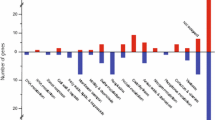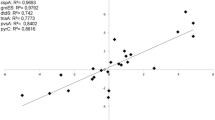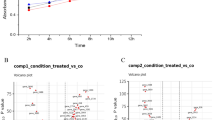Abstract
Vibrio natriegens has massive biotechnological potential owing to its fast growth rate. However, this bacterium rapidly loses its culturability during low-temperature preservation (LTP), the reason for which is still unknown. To reveal the metabolic responses of V. natriegens during LTP, we analyzed and compared the transcriptome before and after 8 days of preservation at 4 or 25 °C (room-temperature preservation (RTP)) in liquid culture medium. Most genes exhibited significant transcriptional responses to LTP. Using gene set enrichment analysis, we compared the transcriptional responses of different V. natriegens Gene Ontology (GO) sets during LTP or RTP. The enrichment of the GO set “SOS response” during LTP, but not RTP, indicated the occurrence of DNA damage during LTP. The GO set “respiratory electron transport chain” was suppressed during LTP and RTP. Although the GO set “response to oxidative stress” was not significantly altered, we observed an increase in reactive oxygen species (ROS) during LTP, suggesting a relationship between ROS and cold-induced loss of culturability (CILC) in V. natriegens. The faster loss of culturability and accumulation of ROS in 20 mL compared to 100 mL of liquid culture medium further suggested a relationship between CILC and oxygen availability. Furthermore, we showed that the deletion of Na+-translocating NADH-ubiquinone oxidoreductase, but not type-II NADH dehydrogenase, accelerated CILC and increased intracellular ROS levels in V. natriegens. These findings will help to understand the cause of CILC which may lead to improving the stability of V. natriegens at low temperatures.
Key points
• V. natriegens transcriptome was analyzed before and after storage at 4 or 25 °C.
• V. natriegens SOS response was induced by 4 °C storage.
• Medium volume, NaCl concentration, and nqr deletion affect the CILC of V. natriegens.




Similar content being viewed by others
Data availability
The RNA-seq raw data were submitted to NCBI-SRA (BioProject number: PRJNA740182) in the NCBI BioProject database. All other data are included in this article and its supplementary information files.
References
Arana I, Muela A, Iriberri J, Egea L, Barcina I (1992) Role of hydrogen peroxide in loss of culturability mediated by visible light in Escherichia coli in a freshwater ecosystem. Appl Environ Microbiol 58:3903–3907
Armada SP, Farto R, Perez MJ, Nieto TP (2003) Effect of temperature, salinity and nutrient content on the survival responses of Vibrio splendidus biotype I. Microbiol-SGM 149:369–375
Avendano-Perez G, Pin C (2013) Loss of culturability of Salmonella enterica subsp. enterica serovar Typhimurium upon cell-cell contact with human fecal bacteria. Appl Environ Microbiol 79:3257–3263
Bates TC, Oliver JD (2004) The viable but nonculturable state of Kanagawa positive and negative strains of Vibrio parahaemolyticus. J Microbiol 42:74–79
Bernhofer M, Dallago C, Karl T, Satagopam V, Heinzinger M, Littmann M, Olenyi T, Qiu J, Schütze K, Yachdav G, Ashkenazy H, Ben-Tal N, Bromberg Y, Goldberg T, Kajan L, O'Donoghue S, Sander C, Schafferhans A, Schlessinger A et al (2021) PredictProtein - Predicting protein structure and function for 29 years. Nucleic Acids Res 49:W535–W540
Bertani G (1951) Studies on lysogenesis. I. The mode of phage liberation by lysogenic Escherichia coli. J Bacteriol 62(3):293–300
Bryan PJ, Steffan RJ, DePaola A, Foster JW, Bej AK (1999) Adaptive response to cold temperatures in Vibrio vulnificus. Curr Microbiol 38:168–175
Conesa A, Gotz S, Garcia-Gomez JM, Terol J, Talon M, Robles M (2005) Blast2GO: a universal tool for annotation, visualization and analysis in functional genomics research. Bioinformatics 21:3674–3676
Cuny C, Dukan L, Fraysse L, Ballesteros M, Dukan S (2005) Investigation of the first events leading to loss of culturability during Escherichia coli starvation: future nonculturable bacteria form a subpopulation. J Bacteriol 187:2244–2248
Das S, McClain CJ, Rai SN (2020) Fifteen years of gene set analysis for high-throughput genomic data: a review of statistical approaches and future challenges. Entropy 22(4):427. https://doi.org/10.3390/e22040427
Dibrov P, Dibrov E, Pierce GN (2017) Na+-NQR (Na+-translocating NADH:ubiquinone oxidoreductase) as a novel target for antibiotics. FEMS Microbiol Rev 41(5):653–671
Eagon RG (1962) Pseudomonas natriegens, a marine bacterium with a generation time of less than 10 minutes. J Bacteriol 83:736–737
Figurski DH, Helinski DR (1979) Replication of an origin-containing derivative of plasmid RK2 dependent on a plasmid function provided in trans. Proc Natl Acad Sci USA 76(4):1648–1652
Geissmann Q (2013) OpenCFU, a new free and open-source software to count cell colonies and other circular objects. PLoS One 8:e54072
Gibson DG, Young L, Chuang RY, Venter JC, Hutchison CA, Smith HO (2009) Enzymatic assembly of DNA molecules up to several hundred kilobases. Nat Methods 6:343–U41
Hansen M, Ramsussen MA, Skov T, Clausen A, Risbo J (2018) The possible causal relationship between fragmentation of genomic DNA and formation of viable, but non-culturable probiotic bacteria upon storage in dry state. Biotechnol Prog 34:231–242
Herrero M, de Lorenzo V, Timmis KN (1990) Transposon vectors containing non-antibiotic resistance selection markers for cloning and stable chromosomal insertion of foreign genes in Gram-negative bacteria. J Bacteriol 172:6557–6567
Hoefman S, Van Hoorde K, Boon N, Vandamme P, De Vos P, Heylen K (2012) Survival or revival: long-term preservation induces a reversible viable but non-culturable state in methane-oxidizing bacteria. PLoS One 7(4):e34196
Hoff J, Daniel B, Stukenberg D, Thuronyi BW, Waldminghaus T, Fritz G (2020) Vibrio natriegens: an ultrafast-growing marine bacterium as emerging synthetic biology chassis. Environ Microbiol 22(10):4394–4408
Hoffart E, Grenz S, Lange J, Nitschel R, Müller F, Schwentner A, Feith A, Lenfers-Lücker M, Takors R, Blombach B (2017) High substrate uptake rates empower Vibrio natriegens as production host for industrial biotechnology. Appl Environ Microbiol 83(22):e01614–e01617
Imamura D, Mizuno T, Miyoshi S, Shinoda S (2015) Stepwise changes in viable but nonculturable Vibrio cholerae cells. Microbiol Immunol 59:305–310
Janion C (2008) Inducible SOS response system of DNA repair and mutagenesis in Escherichia coli. Int J Biol Sci 4(6):338–344
Kong IS, Bates TC, Hulsmann A, Hassan H, Smith BE, Oliver JD (2004) Role of catalase and oxyR in the viable but nonculturable state of Vibrio vulnificus. FEMS Microbiol Ecol 50:133–142
Kreuzer KN (2013) DNA damage responses in prokaryotes: regulating gene expression, modulating growth patterns, and manipulating replication forks. Cold Spring Harb Perspect Biol 5(11):a012674
Lee HH, Ostrov N, Wong BG, Gold MA, Khalil AS, Church GM (2019) Functional genomics of the rapidly replicating bacterium Vibrio natriegens by CRISPRi. Nat Microbiol 4:1105–1113
Lin PC, Turk K, Hase CC, Fritz G, Steuber J (2007) Quinone reduction by the Na+-translocating NADH dehydrogenase promotes extracellular superoxide production in Vibrio cholerae. J Bacteriol 189:3902–3908
Maslowska KH, Makiela-Dzbenska K, Fijalkowska IJ (2019) The SOS system: a complex and tightly regulated response to DNA damage. Environ Mol Mutagen 60(4):368–384
Meng L, Alter T, Aho T, Huehn S (2015) Gene expression profiles of Vibrio parahaemolyticus in viable but non-culturable state. FEMS Microbiol Ecol 91(5):fiv035. https://doi.org/10.1093/femsec/fiv035
Mootha VK, Lindgren CM, Eriksson KF, Subramanian A, Sihag S, Lehar J, Puigserver P, Carlsson E, Ridderstrale M, Laurila E, Houstis N, Daly MJ, Patterson N, Mesirov JP, Golub TR, Tamayo P, Spiegelman B, Lander ES, Hirschhorn JN et al (2003) PGC-1α-responsive genes involved in oxidative phosphorylation are coordinately downregulated in human diabetes. Nat Genet 34(3):267–273
Pasquaroli S, Zandri G, Vignaroli C, Vuotto C, Donelli G, Biavasco F (2013) Antibiotic pressure can induce the viable but non-culturable state in Staphylococcus aureus growing in biofilms. J Antimicrob Chemother 68:1812–1817
Payne WJ (1958) Studies on bacterial utilization of uronic acids III: induction of oxidative enzymes in a marine isolate. J Bacteriol 76:301–307
Pfeifer E, Michniewski S, Gätgens C, Münch E, Müller F, Polen T, Millard A, Blombach B, Frunzke J, Stabb EV (2019) Generation of a prophage-free variant of the fast-growing bacterium Vibrio natriegens. Appl Environ Microbiol 85(17):e00853–e00819
R Core Team (2020) R: A language and environment for statistical computing. http://www.R-project.org
Rost B, Sander C (1993) Improved prediction of protein secondary structure by use of sequence profiles and neural networks. Proc Natl Acad Sci USA 90:7558–7562
Schäfer A, Tauch A, Jäger W, Kalinowski J, Thierbach G, Pühler A (1994) Small mobilizable multi-purpose cloning vectors derived from the Escherichia coli plasmids pK18 and pK19: selection of defined deletions in the chromosome of Corynebacterium glutamicum. Gene 145:69–73
Sellamuthu S, Singh M, Kumar A, Singh SK (2017) Type-II NADH dehydrogenase (NDH-2): a promising therapeutic target for antitubercular and antibacterial drug discovery. Expert Opin Ther Targets 21(6):559–570
Simon R, Priefer U, Pühler A (1983) A broad host range mobilization system for in vivo genetic engineering: transposon mutagenesis in Gram-negative bacteria. Cold Spring Harb Perspect Biol 1:784–791
Subramanian A, Tamayo P, Mootha VK, Mukherjee S, Ebert BL, Gillette MA, Paulovich A, Pomeroy SL, Golub TR, Lander ES, Mesirov JP (2005) Gene set enrichment analysis: a knowledge-based approach for interpreting genome-wide expression profiles. Proc Natl Acad Sci USA 102(43):15545–15550
Sung H-H, Chen C-K, Shih P-A, Hsu P-C (2006) Induction of viable but non-culturable state in Vibrio cholerae O139 by temperature and its pathogenicity. J Food Drug Anal 14:265–272
Wang Z, Tschirhart T, Schultzhaus Z, Kelly EE, Chen A, Oh E, Nag O, Glaser ER, Kim E, Lloyd PF, Charles PT, Li W, Leary D, Compton J, Phillips DA, Dhinojwala A, Payne GF, Vora GJ, Johnson KN (2020) Melanin produced by the fast-growing marine bacterium Vibrio natriegens through heterologous biosynthesis: characterization and application. Appl Environ Microbiol 86(5):e02749–e02719
Weinstock MT, Hesek ED, Wilson CM, Gibson DG (2016) Vibrio natriegens as a fast-growing host for molecular biology. Nat Methods 13:849
Wickham H (2016) ggplot2: elegant graphics for data analysis. Springer-Verlag, New York
Wolf PW, Oliver JD (1992) Temperature effects on the viable but non-culturable state of Vibrio vulnificus. FEMS Microbiol Ecol 101:33–39
Wong HC, Wang P (2004) Induction of viable but nonculturable state in Vibrio parahaemolyticus and its susceptibility to environmental stresses. Lett Appl Microbiol 96:359–366
Wu B, Liang WL, Kan BA (2016) Growth phase, oxygen, temperature, and starvation affect the development of viable but non-culturable state of Vibrio cholerae. Front Microbiol 7:404
Zhong L, Chen J, Zhang XH, Jiang YA (2009) Entry of Vibrio cincinnatiensis into viable but nonculturable state and its resuscitation. Lett Appl Microbiol 48:247–252
Funding
This study was supported by the National Natural Science Foundation of China (31900085, 41907219), the Zhejiang Provincial Natural Science Foundation (LQ19C010003), the Medical and Health Research Projects of Hangzhou Municipality (A20200063), and the International Exchange and Cooperation Project of the Department of International Cooperation, Ministry of Agriculture and Rural Affairs of China (12210032).
Author information
Authors and Affiliations
Contributions
SW conceived and designed the study. SW and BW conducted the experiments. SW analyzed the data and wrote the manuscript. XY and LD managed the laboratory and provided the resources and funding. All the authors have read and approved the manuscript.
Corresponding authors
Ethics declarations
Ethical approval
This article does not include any studies with human participants.
Conflict of interest
The authors declare no competing interests.
Additional information
Publisher’s note
Springer Nature remains neutral with regard to jurisdictional claims in published maps and institutional affiliations.
Rights and permissions
Springer Nature or its licensor (e.g. a society or other partner) holds exclusive rights to this article under a publishing agreement with the author(s) or other rightsholder(s); author self-archiving of the accepted manuscript version of this article is solely governed by the terms of such publishing agreement and applicable law.
About this article
Cite this article
Wang, S., Wang, B., You, X. et al. Transcriptomic responses of the fast-growing bacterium Vibrio natriegens during cold-induced loss of culturability. Appl Microbiol Biotechnol 107, 3009–3019 (2023). https://doi.org/10.1007/s00253-023-12487-3
Received:
Revised:
Accepted:
Published:
Issue Date:
DOI: https://doi.org/10.1007/s00253-023-12487-3




